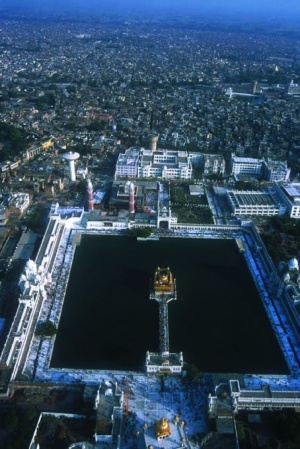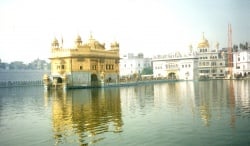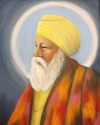Template:AOW41
Harimandir Sahib: Literally "Temple of God."; Punjabi
A Gurdwara of historical, spiritual, and emotional significance to Sikhs, called Harimandir Sahib in Punjabi. Guru Amar Das first conceived of it, although construction did not begin until Guru Ram Das became the Guru. Maharaja Ranjit Singh had the structure plated with gold in the early 19th century for the first time. During 2003, the gold plating was replaced with new gold. In 1604, the recently compiled Adi Granth was housed here for the first time. The Fifth Guru, Guru Arjan Dev ji sat on the floor with the rest of the congregation while the Adi Granth was place on a high platform or Takhat. The Indian army attacked this beautiful complex in June 1984 causing severe damage to the Akal Takhat building complex.
Background
Harimander Sahib is the most famous Sikh temple or Gurdwara. It is also called the Golden Temple in English because of the gold plating that covers most of its surface. This Gurdwara is found in the holy city of Amritsar in Punjab in North West India and is the sacred and the most visited of the many historic Sikhs shrines found in India and Pakistan. This striking building was built by the Guru Arjan Dev, the fifth Guru of the Sikhs.
Guru Nanak (15 April 1469 - 7 May 1539),is the founder of Sikhism and the first of the ten Gurus of the Sikhs. He was born in the village of Talwandi also called Rai Bhoeki Talwandi, now known as Nankana Sahib, near Lahore in present-day Pakistan. He was born, according to all ancient Sikh records, in the early morning of the third day of the light half of the month of Baisakh (Apil-May) in the year 1469 AD; but for conveniance sake his anniversary is now observed by the Sikhs on the occaision of the full moon in the month of Kartik (October-November). Before Guru Nanak breathed his last in 1539, his name had travelled not only throughout India's north, south, east and west, but also far beyond into Arabia, Messopotania, Ceylon, Afghanistan, Burma and Tibet.



